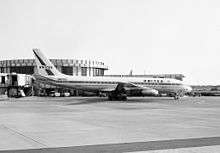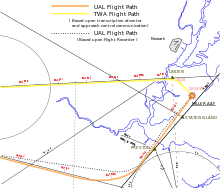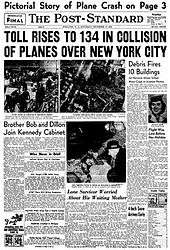1960 New York mid-air collision
| Accident | |
|---|---|
| Date | 16 December 1960 |
| Summary | Mid-air collision |
| Site |
About a mile west of Miller Field 40°34′07″N 74°07′19″W / 40.56861°N 74.12194°WCoordinates: 40°34′07″N 74°07′19″W / 40.56861°N 74.12194°W |
| Total fatalities | 134 (133 initially, including 6 on the ground) |
| Total injuries | 0 (1 initially) |
| Total survivors | 0 (1 initially) |
| First aircraft | |
 N8010U, a sister-ship to the accident aircraft | |
| Type | Douglas DC-8-11 |
| Name | Mainliner Will Rogers |
| Operator | United Airlines |
| Registration | N8013U |
| Flight origin | Chicago-O'Hare International Airport (ORD/KORD), IL |
| Destination | Idlewild Airport (IDL/KIDL)(Now John F. Kennedy International Airport), New York City |
| Passengers | 77 |
| Crew | 7 |
| Fatalities | 84 (83 initially) |
| Injuries | 0 (1 initially) |
| Survivors | 0 (1 initially) |
| Second aircraft | |
|
N6937C, an air-worthy restored L-1049H Super Constellation, wearing TWA livery. | |
| Type | Lockheed L-1049 Super Constellation |
| Name | Star of Sicily |
| Operator | Trans World Airlines |
| Registration | N6907C |
| Flight origin | Dayton International Airport (DAY/KDAY), Dayton, Ohio |
| Stopover | Port Columbus International Airport (CMH/KCMH), Ohio |
| Destination | LaGuardia Airport KLGA New York |
| Passengers | 39 |
| Crew | 5 |
| Fatalities | 44 (all) |
| Survivors | 0 |


On Friday, December 16, 1960, a United Airlines Douglas DC-8, bound for Idlewild Airport (later renamed John F. Kennedy International Airport) in New York City, collided with a TWA Lockheed L-1049 Super Constellation descending into the city's LaGuardia Airport.[1] One plane crashed on Staten Island, the other into Park Slope, Brooklyn, killing all 128 people on both aircraft and six people on the ground. The accident became known also as the Park Slope plane crash.[2] On Staten Island, it became known as the Miller Field crash.
Aircraft and crews
United Airlines Flight 826, Mainliner Will Rogers, registration N8013U,[3] was a DC-8-11 carrying 84 people en route from O'Hare International Airport in Chicago to Idlewild Airport. The DC-8 model had entered commercial service only 15 months earlier, with United as one of its launch customers. On Flight 826, the flight crew consisted of Captain Robert Sawyer, First Officer Robert Fieberg, Flight Engineer Richard Pruitt, and Stewardesses Annabelle Marie Bothun, Augustine Ferrer, Patricia Keller, and Mary Mahoney.
Trans World Airlines Flight 266, Star of Sicily, registration N6907C,[4] was a Super Constellation carrying 44 people en route from Dayton and Columbus, Ohio, to LaGuardia Airport in Queens. The flight crew of Flight 266 was Captain David Wollam, First Officer Dean Bowen, Flight Engineer LeRoy Rosenthal, and Stewardesses Margaret Gernat and Patricia Post.[5]
Accident
At 10:21 A.M. Eastern Time, the United aircraft advised its company radio operator that one of its VOR receivers had stopped working (although air-traffic controllers were not notified of the problem), making it harder to navigate in instrument conditions. At 10:25 A.M. Eastern Time, air traffic control issued a revised clearance for the flight to shorten its course to the Preston holding point (near South Amboy, New Jersey) by 12 miles (19 km). The United aircraft was supposed to circle the holding point at an altitude of 5,000 ft (1,500 m) at no more than 240 mph (210 kn; 390 km/h), but overshot it. United later said the Colts Neck VOR equipment was unreliable (pilots testified on both sides of the issue).[6] ("Preston" was the point where airway V123 — the 050-radial off the Robbinsville VOR — crossed the Solberg 120-degree radial and the Colts Neck 346-degree radial.)
The prevailing conditions were light rain and fog (which had been preceded by snowfall). According to information from the United DC-8's flight data recorder (the first time a "black box" had been used to provide extensive details in a crash investigation), the aircraft was 12 miles (19 km) off course and, for 81 seconds, had descended at 3,600 feet per minute (18 m/s), and slowed from more than 500 to 363 mph (434 to 315 kn; 805 to 584 km/h). It collided with the TWA Constellation, one right engine of the DC-8 impacting just ahead of the Constellation's wings. The Constellation's fuselage was torn apart violently, and the DC-8's colliding engine was torn from its pylon.
The Constellation entered a dive, with debris being blasted out of the aircraft as it spiraled to the ground. The DC-8, having lost one engine and a large part of the right wing, managed to remain in flight for another minute and a half.
The TWA plane crashed onto the northwest corner of Miller Field, at 40°34′11.07″N 74°6′11.62″W / 40.5697417°N 74.1032278°W, with some sections of the aircraft landing in New York Harbor on the Atlantic Ocean side. As it spiraled down, it disintegrated, dropping at least one passenger into a tree in nearby New Dorp.[6][1]
Although witnesses speculated at the time that the crew of the United plane was attempting an emergency landing either in Prospect Park (about 9 miles (14 km) away from the collision point) or at LaGuardia Airport, there is no firm evidence that the pilots had control of the DC-8 at any time after the collision. The crash left the remains of the aircraft pointed southeast towards a large open field at Prospect Park, only blocks from the crash site.
A teacher at a school less than two blocks from the crash later testified that he saw the faces of pilots as the plane approached the school, and that the wing dipped to clear the school building just before the plane crashed. A student at the school who lived in one of the destroyed apartment buildings said that his family survived because they happened to be in the only room of their apartment not destroyed. The crash left a trench covering most of the length of middle of Sterling Place. Occupants of the school thought that a bomb had gone off or that the building's boiler had exploded.
There was no radio contact with traffic controllers from either plane after the collision, although LaGuardia had begun tracking an incoming, fast-moving, unidentified plane from Preston toward the LaGuardia "Flatbush" outer marker.[7]
The DC-8 crashed into the Park Slope section of Brooklyn at the intersection of Seventh Avenue and Sterling Place (40°40′38″N 73°58′25″W / 40.67709°N 73.97368°W), scattering wreckage and setting fire to ten brownstone apartment buildings, the Pillar of Fire Church, the McCaddin Funeral Home, a Chinese laundry, and a delicatessen. Six people on the ground were killed.[8][1]
Initial survivor
The only initial survivor of the crash was 11-year-old Stephen Lambert Baltz (born January 9, 1949) of Wilmette, Illinois. He was traveling unaccompanied as part of his family's plans to spend Christmas in Yonkers with relatives. Baltz was thrown from the plane into a snowbank where his burning clothing was extinguished. Although alive and conscious, he was badly burned and had inhaled burning fuel.[8] He died of pneumonia the next day.[9] A plaque in the hospital's chapel memorializing the crash's victims displays four U.S. dimes and five U.S. nickels found in Baltz's pocket.[5][10]
See also
References
- 1 2 3 "U.S. Civil Aeronautics Board Aircraft Accident Report" (PDF). archive.org. June 18, 1962. Retrieved July 7, 2017.
- ↑ "Park Slope Plane Crash". The New York Times. December 16, 2010. Retrieved March 12, 2011.
- ↑ "FAA Registry (N8013U)". Federal Aviation Administration.
- ↑ "FAA Registry (N6907C)". Federal Aviation Administration.
- 1 2 "1960 plane collision over NYC spurred improvements," The Associated Press, Wednesday, December 15, 2010.
- 1 2 "High Speed Laid to Jet in Crash. Inquiry Told Craft Overshot Circle Area at 500 M.P.H". The New York Times. January 10, 1961. Retrieved March 12, 2011.
The jet airliner in the 16 December collision here was traveling more than 500 miles an hour when it swept past its assigned circling point, an official inquiry was told yesterday.
- ↑ Excerpts of Tape Conversations at Time of Air Crash — New York Times — December 22, 1960
- 1 2 Disaster in Fog — New York Times — December 17, 1960
- ↑ Perlmutter, Emanuel (December 18, 1960). "Boy Who Survived Crash Dies; 'Stevie Tried Hard,' Father Says". The New York Times. p. 49.
- ↑ Dunlap, David W. "In Remembrance of Sorrow From Other Times," The New York Times, Friday, January 25, 2002.
External links
- Pillar of Fire: Recalling the Day the Sky Fell, December 16, 1960 by Nathaniel Altman, from the Park Slope Reader
- U.S. Civil Aeronautics Board Aircraft Accident Report (text) from the U.S. Department of Transportation Special Collections.
- Accident description TWA Super Constellation L-1049 N6907C
- Accident description United Airlines DC-8-11 N8013U
- Pre-crash photo of N6907C
- Death in the Air, Time, December 26, 1960.
- Newsreel film footage of crash
- Nelson, Libby. "The Boy Who Survived a 1960 Midair Crash" (Archive). The New York Times. June 30, 2009.
- "127 die as 2 airliners collide over city; jet sets Brooklyn fire, killing 5 others; second plane crashes on Staten Island" (Archive). The New York Times. Vol CX. No. 37,583. Saturday December 17, 1960.
- Park Slope Plane Crash, City Room (The New York Times local news blog), Sunday, December 12–Thursday, December 16, 2010 – A series of articles about the aviation disaster.
- CNN photo gallery of the crash
- Deadly Brooklyn Plane Crash, 1960 – slideshow by Life magazine
- Pillar of Fire – Interview with Dorothy M. Fletcher by Nathaniel Altman
- Fate or fluke? Air crash sole survivors by Barry Neild for CNN
- Wendell Jamieson (March 24, 2002). "The Day the Boy Fell From the Sky". The New York Times.
- "Park Slope Plane Crash". The New York Times. December 12–16, 2010. Retrieved December 17, 2010.
- "1960 New York City plane crash: A look back". – slideshow by New York Daily News